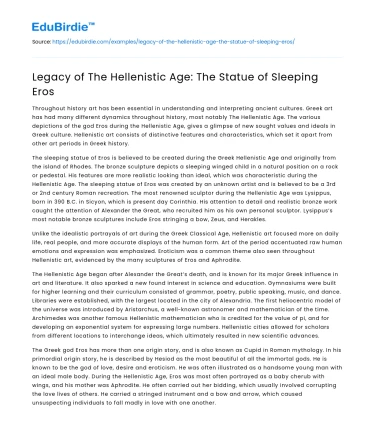Throughout history art has been essential in understanding and interpreting ancient cultures. Greek art has had many different dynamics throughout history, most notably The Hellenistic Age. The various depictions of the god Eros during the Hellenistic Age, gives a glimpse of new sought values and ideals in Greek culture. Hellenistic art consists of distinctive features and characteristics, which set it apart from other art periods in Greek history.
The sleeping statue of Eros is believed to be created during the Greek Hellenistic Age and originally from the island of Rhodes. The bronze sculpture depicts a sleeping winged child in a natural position on a rock or pedestal. His features are more realistic looking than ideal, which was characteristic during the Hellenistic Age. The sleeping statue of Eros was created by an unknown artist and is believed to be a 3rd or 2nd century Roman recreation. The most renowned sculptor during the Hellenistic Age was Lysippus, born in 390 B.C. in Sicyon, which is present day Corinthia. His attention to detail and realistic bronze work caught the attention of Alexander the Great, who recruited him as his own personal sculptor. Lysippus’s most notable bronze sculptures include Eros stringing a bow, Zeus, and Herakles.
Save your time!
We can take care of your essay
- Proper editing and formatting
- Free revision, title page, and bibliography
- Flexible prices and money-back guarantee
Unlike the idealistic portrayals of art during the Greek Classical Age, Hellenistic art focused more on daily life, real people, and more accurate displays of the human form. Art of the period accentuated raw human emotions and expression was emphasized. Eroticism was a common theme also seen throughout Hellenistic art, evidenced by the many sculptures of Eros and Aphrodite.
The Hellenistic Age began after Alexander the Great’s death, and is known for its major Greek influence in art and literature. It also sparked a new found interest in science and education. Gymnasiums were built for higher learning and their curriculum consisted of grammar, poetry, public speaking, music, and dance. Libraries were established, with the largest located in the city of Alexandria. The first heliocentric model of the universe was introduced by Aristarchus, a well-known astronomer and mathematician of the time. Archimedes was another famous Hellenistic mathematician who is credited for the value of pi, and for developing an exponential system for expressing large numbers. Hellenistic cities allowed for scholars from different locations to interchange ideas, which ultimately resulted in new scientific advances.
The Greek god Eros has more than one origin story, and is also known as Cupid in Roman mythology. In his primordial origin story, he is described by Hesiod as the most beautiful of all the immortal gods. He is known to be the god of love, desire and eroticism. He was often illustrated as a handsome young man with an ideal male body. During the Hellenistic Age, Eros was most often portrayed as a baby cherub with wings, and his mother was Aphrodite. He often carried out her bidding, which usually involved corrupting the love lives of others. He carried a stringed instrument and a bow and arrow, which caused unsuspecting individuals to fall madly in love with one another.
The statue of sleeping Eros has an innocent and playful looking sense to it. His presence is whimsical and light hearted. It showed a great amount of work and planning went into creating this piece. Although it is not certain if it is an original or a Roman recreation, it obviously was significant during its time. Though earlier myths depicted Eros as an adult, it’s a refreshing change to see a god represented as a child. As an adult he was illustrated with a perfect body, and as a child he has a more realistic natural form. Eros or Cupid is still relevant in this day in age. He is celebrated during Valentine’s Day as a capricious winged child that is still associated with love and desire. Although the Hellenistic Age is long gone, its legacy is still significant today.






 Stuck on your essay?
Stuck on your essay?

